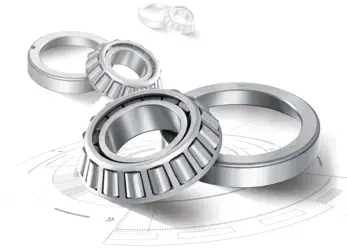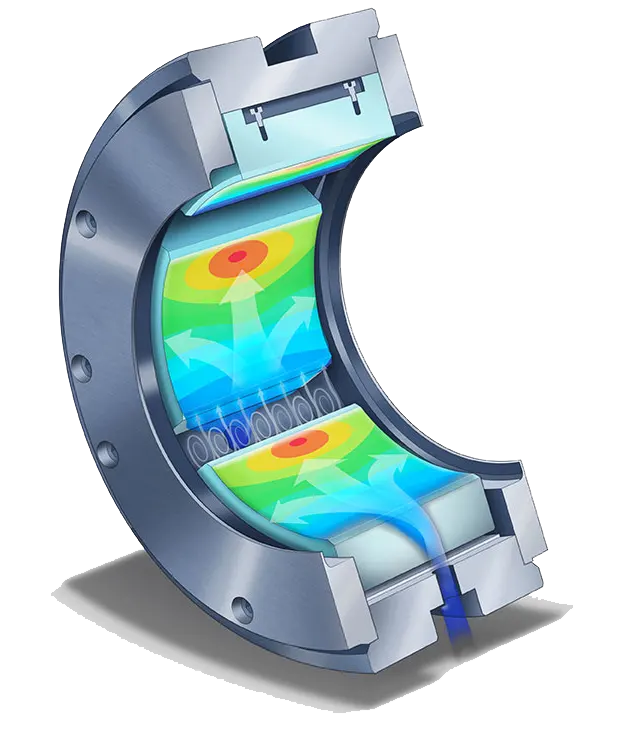Tapered roller bearings are integral components in mechanical engineering, allowing for both radial and axial loads. From automotive wheel hubs to industrial machinery, their efficiency and service life are of utmost importance. Among the most influential parameters upon performance, the microgeometry of the bearing components plays an important role.
Defining Microgeometry in Bearings
Microgeometry refers to the minute, highly engineered deviations from ideal geometric shapes on bearing component surfaces. These minute modifications, usually in the micrometer range, include features such as surface roughness, waviness, and the profiling of rolling elements and raceways with high precision. While microgeometry deals with the overall shape and dimensions, microgeometry involves fine-tuning the surface characteristics for optimization of performance under specific operating conditions.
Importance of Small Design Details in High-Performance Applications
In high-performance applications, heavy-capacity bearings running under circumstances of very high speeds at different temperatures comparatively small details in the configuration can have enormous effects. Thus, the optimization of microgeometry will lead to:
- Improved Load Distribution : The even distribution of load in the rolling elements minimizes peak stresses and extends bearing life.
- Reduced Friction and Wear : Smoother surfaces and optimized profiles reduce friction to a minimum, thereby improving efficiency by reducing wear rates.
- Improved Lubrication : Microgeometry provides an opportunity for the creation of the lubricant film, which is so important to avoid metal-to-metal contact and prevent early failure.
- Noise and Vibration Reduction : The precision in microgeometry can decrease the sources of noise and vibration, vital for applications needing quiet operation.
Accurate understanding and realization of micro geometric adjustments are quite important for performance and reliability in the application of tapered roller bearings under extreme, harsh conditions. For optimal results, sourcing from a trusted taper roller bearings manufacturer can significantly enhance durability and efficiency.
Microgeometry Elements in Tapered Roller Bearings
The performance of tapered roller bearings is closely related to the microgeometry of its components. The main components are surface finish, contact profiles, roller crown profiles, and edge radii.
Surface Finish and Contact Profile
The surface finish refers to the microscopic deviations on the bearing surfaces. These are further characterized by parameters such as roughness and waviness. An optimal surface finish ensures:
- Improved Formation of the Lubricant Film : A finely finished surface allows for the development of a consistent lubricant film, reducing direct metal contact and wear.
- Reduced Friction : Smooth surfaces lessen frictional resistance, which then reduces operating temperatures and, in general, increases efficiency.
The contact profile is the particular geometric shape of the contact area between the rolling elements and raceways. Proper profiling ensures even distribution of stress and prevents the risk of local fatigue, thus prolonging the life of the bearing.

Roller Crown Profiles and Edge Radii
The roller crown profiles are slight curvatures applied to the rolling elements other than the perfect cylindrical shape. This is called crowning, which avoids certain problems that may arise due to edge loading, where the major concentration of stresses happens to be at the ends of the rollers, and may well result in premature failure. By employing an optimum crowned profile, the stress distributes more evenly along the length of the roller, thereby increasing the load-carrying capacity and durability.
The edge radii are rounded transitions at the edges of the rolling elements and raceways. Sharp edges may provide stress risers that initiate cracks and accelerate fatigue. The incorporation of appropriate edge radii reduces stress concentrations, adding to the robustness of the bearing.
A study on the effect of roller geometry on bearing load-life relations identifies that a full crown with a crown radius of 150 times the roller diameter avoids stress concentration at the ends but may increase it at the center of the roller. A balanced approach is, therefore, necessary in designing the crown profile to optimize the performance.
In other words, paying special attention in development to the microgeometry elements of surface finish, contact profiles, roller crown profiles, and edge radii offers vital opportunities for performance improvement in tapered roller bearings and thus extends their service life.
How Microgeometry Enhances Performance
Microgeometry of tapered roller bearings can play a crucial role in their performance enhancement by reducing friction and heat generation, besides load-carrying capacity and longevity.
Reduction in Friction and Heat Generation
Optimizing the microgeometry of bearing components reduces friction and heat generation significantly:
- Surface Smoothness : A finely polished surface finish minimizes asperities, reducing frictional resistance between contact surfaces.
- Lubricant Film Stability : Proper microgeometry promotes a stable lubricant film; the latter acts as a barrier to direct metal-to-metal contact, hence decreasing friction along with the associated heat.
- Contact Profile Optimization : The optimization of the contact profiles will result in the distribution of load over a larger area and thus reduce the localized pressures, which are contributing to friction and heat.
In research relating to the study of roller profile type about the results of calculations of the expected life with cylindrical-roller bearings, it becomes apparent how edge loading in bearings stands to provide bad or deleterious outcomes effect perhaps mitigable when a completely or partly crowning of roller profile shape will apply, alternatively to that which was considered in design for a common flat one because of producing less friction or heat-generating friction in the operational process.

Improved Load Carrying Capacity and Longevity
The microgeometry of bearings has a great effect on load-carrying capacity and service life:
- Stress Distribution : Optimized roller crown profiles and edge radii ensure even stress distribution across the contact surfaces, preventing the concentration of stress that leads to material fatigue.
- Improved Material Fatigue Resistance : A reduction of peak stresses by way of micro geometric adjustments serves to increase material resistance to fatigue and, therefore, prolongs the operational life of the bearing.
- Load Accommodation : With precisely engineered microgeometry, bearings can support higher loads without loss of performance and are appropriate for particularly demanding applications.
It follows that the research on the analysis of contact pressure distribution in tapered roller bearings shows the dependence of the shape and microgeometry of the roller on the distribution of contact pressure. Uniform contact pressure develops smaller material fatigue and increases operational life. This further confirms that microgeometry design requires high accuracy for maximum load-carrying capacity and durability.
Design Tools and Techniques
The advanced tools, techniques, and manufacturing processes are only able to give optimum microgeometry for tapered roller bearings. Development in this area has drastically changed the capability to design and produce bearings that meet the most rigid performance requirements.
Advanced Simulation and Analysis Tools
Modern engineering design and analysis of bearing microgeometry are highly dependent on the support of computer-aided tools. Some of the key developments in this area include:
- Finite Element Analysis (FEA) : This is a technique that models the distribution of stresses and deformation of bearing elements under various loads and operating conditions. Engineers also use FEA in fine-tuning the roller crown profiles and edge radii for optimum distribution of stresses.
- Simulation of Contact Mechanics : Advanced algorithms are used to simulate contact between rolling elements and raceways, taking into account surface roughness, contact area, and lubricant behavior. The simulations support performance prediction in real conditions.
- Tribology Analysis : The software tools analyze friction, wear, and lubrication phenomena to enable engineers the optimize surface finishes and microgeometry with minimum energy losses.
- Digital Twins : Virtual representations of real bearings that can predict performance and failure modes by using real-time data and simulations, which allow iterative microgeometry improvements.
Role of Precision Manufacturing
Manufacturing processes are important for converting microgeometry designs into actuality. Some of the key techniques used in the manufacturing process include:
- Superfinishing : It involves a process that gives extremely smooth surfaces to the components of bearings, hence decreasing friction and increasing the efficiency of lubrication. Superfinishing contributes to attaining specific surface roughness that is considered important for load-carrying performance.
- Grinding and Polishing : Precision grinding ensures the right shaping concerning rollers and rows, while polishing removes any possible micro defects, which badly worsen performance.
- Computer Numerical Control (CNC) Machining : This is a process that involves the use of computers programmed with specific languages to produce highly detailed microgeometric profiles while achieving great accuracy. Such technology can easily maintain consistency over large production volumes.
- Metrology and Quality Control : Advanced metrology tools, like 3D laser scanners and atomic force microscopes, measure and verify the parameters of microgeometry to confirm that they are within design specifications.
By combining these tools and processes, the manufacturers have been able to reach precision in microgeometry never even dreamt of just a couple of decades a new standard in bearing performance.
Applications Across Industries
Optimized microgeometry pays off in so many diverse areas of this important industrial bearing family, the tapered roller bearings. Let us examine a few aspects where microgeometry plays a very significant role in the specific applications of these bearings.

Automotive Industry
In the automotive industry, wheel hubs, transmissions, and differentials depend on tapered roller bearings. Microgeometry improvements can be used to enhance:
- Friction Reduction : Lower friction means reduced losses and, therefore, improved fuel economy.
- Durability : Optimized microgeometry in bearings allows higher load and stress in vehicles, thereby enhancing reliability and reducing maintenance costs.
- NVH Reduction : It minimizes noise, vibration, and harshness for better passenger comfort.

Aerospace Industry
The bearings for aerospace applications have to be such that they function effectively under extreme conditions, such as high speeds, temperatures, and loads. Improvement in microgeometry will provide:
- High Load Resilience : Even distribution of stresses in bearings of aircraft landing gear and engine components.
- Weight Optimization : Precision microgeometry contributes to a reduction in the amount of material used and therefore lighter, more fuel-efficient aircraft.

Heavy Machinery and Industrial Equipment
The Tapered Roller Bearing finds very wide application in construction machinery, mining machinery, and wind turbines. Microgeometry optimization improves:
- Load Carrying Ability : Bearings in these applications support very heavy radial and axial loads, which optimized microgeometry can distribute effectively.
- Longevity : Improved surface finishes and crown profiles ensure longer operational lifespans, even in harsh environments.

Renewable Energy Sector
The bearings of wind turbines are subjected to fluctuating loads and environmental stresses. The microgeometry improvements will lead to:
- Improved Reliability : Reduced wear and friction ensure consistent operation through the life cycle of a turbine.
- Efficiency in Maintenance : The bearings with improved microgeometry have less frequency in lubrication and maintenance; thus, reducing downtime.
By tailoring microgeometry to a particular application, engineers make certain that tapered roller bearings withstand the specific demands of each industry by assuring superior performance and reliability.
Conclusion
Microgeometry is a very important factor in tapered roller bearings. It is such subtle, precise improvements that transform bearing efficiency, by way of load distribution, friction reduction, and increasing service life. In this regard, simulation precision manufacturing and metrology advances have let engineers really push the envelope on bearing performance, thus making them indispensable applications involving high stakes across automotive, aerospace, and industrial sectors.
With increasing demands on the industry for efficiency, durability, and reliability, there will be a further escalation in interest in microgeometry. On the manufacturing side, it is continuous improvement through the latest available tools and techniques that places tapered roller bearings in the position of maintaining the machinery and technologies of contemporary life.